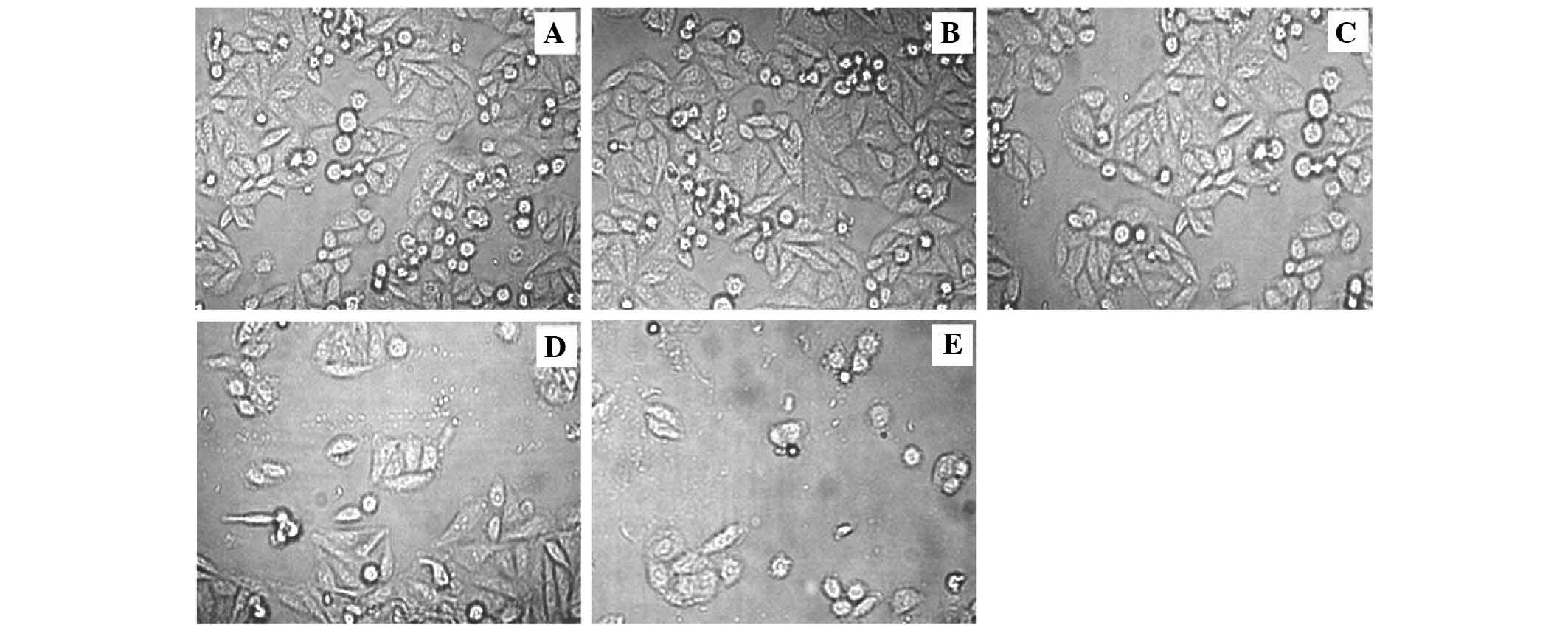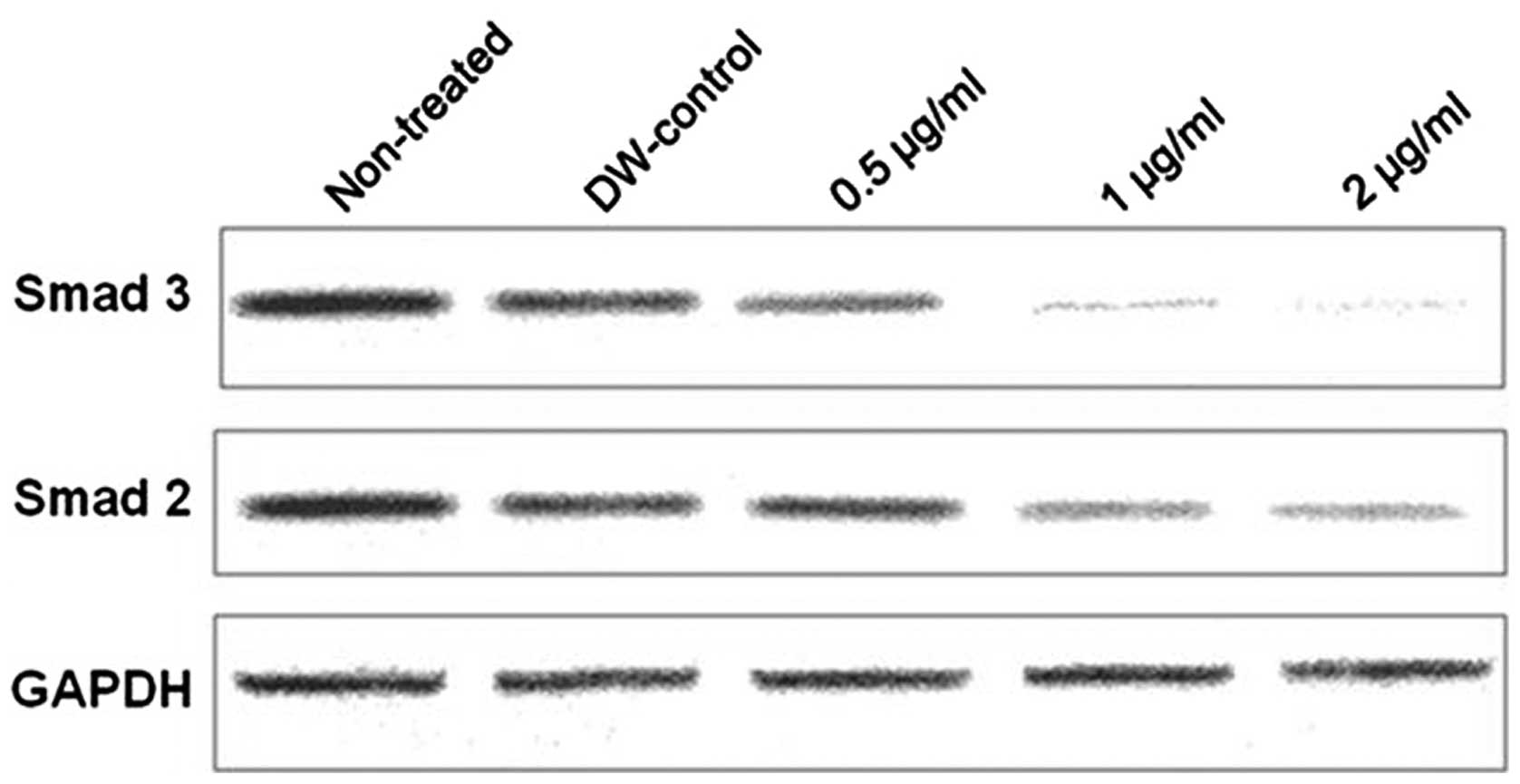|
1
|
Jemal A, Bray F, Center MM, Ferlay J, Ward
E and Forman D: Global cancer statistics. CA Cancer J Clin.
61:69–90. 2011. View Article : Google Scholar : PubMed/NCBI
|
|
2
|
Carmona FJ and Esteller M: Epigenomics of
human colon cancer. Mutat Res. 693:53–60. 2010. View Article : Google Scholar : PubMed/NCBI
|
|
3
|
Kim E, Coelho D and Blachier F: Review of
the association between meat consumption and risk of colorectal
cancer. Nutr Res. 33:983–994. 2013. View Article : Google Scholar : PubMed/NCBI
|
|
4
|
Mishra J, Drummond J, Quazi SH, Karanki
SS, Shaw JJ, Chen B and Kumar N: Prospective of colon cancer
treatments and scope for combinatorial approach to enhanced cancer
cell apoptosis. Crit Rev Oncol Hematol. 86:232–250. 2013.
View Article : Google Scholar :
|
|
5
|
Mohan HM, O'Connor DB, O'Riordan JM and
Winter DC: Prognostic significance of detection of microscopic
peritoneal disease in colorectal cancer: A systematic review. Surg
Oncol. 22:e1–6. 2013. View Article : Google Scholar : PubMed/NCBI
|
|
6
|
Loh KW, Majid HA, Dahlui M, Roslani AC and
Su TT: Sociodemographic predictors of recall and recognition of
colorectal cancer symptoms and anticipated delay in help-seeking in
a multiethnic asian population. Asian Pac J Cancer Prev.
14:3799–3804. 2013. View Article : Google Scholar
|
|
7
|
Ma J, Gao HM, Hua X, Lu ZY and Gao HC:
Role of TGF-β1 in human colorectal cancer and effects after
cantharidinate intervention. Asian Pac J Cancer Prev. 15:4045–4048.
2014. View Article : Google Scholar
|
|
8
|
Bierie B and Moses HL: TGF-β and cancer.
Cytokine Growth Factor Rev. 17:29–40. 2006. View Article : Google Scholar
|
|
9
|
Jean-Jacques L: The dual role of TGF in
human cancer: From tumor suppression to cancer metastasis. ISRN Mol
Biol. 7:1–28. 2012.
|
|
10
|
Bierie B and Moses HL: TGFbeta: The
molecular Jekyll and Hyde of cancer. Nat Rev Cancer. 6:506–520.
2006. View
Article : Google Scholar : PubMed/NCBI
|
|
11
|
Ramasamy S, Nattarayan V, Jayaraj GG,
Arulanandh MD and Jaiswal A: Bacterial infection-mediated
anticancer activity (BIMAc) - revisiting the molecular mechanisms.
J Med Hypoth Ideas. 6:19–22. 2012. View Article : Google Scholar
|
|
12
|
Nauts HC, Fowler GA and Bogatko FH: A
review of the influence of bacterial infection and of bacterial
products (Coley's toxins) on malignant tumors in man; a critical
analysis of 30 inoperable cases treated by Coley's mixed toxins, in
which diagnosis was confirmed by microscopic examination selected
for special study. Acta Medica Scandinavica. 276:1–103. 1953.
|
|
13
|
Nauts HC: The beneficial effects of
bacterial infections on host resistance to cancer: End result in
449 cases. (Monograph no. 8). 2nd edition. Cancer Research
Institute; New York, NY, USA: 1980
|
|
14
|
Zacharski LR and Sukhatme VP: Coley's
toxin revisited: Immunotherapy or plasminogen activator therapy of
cancer? J Thromb Haemost. 3:424–427. 2005. View Article : Google Scholar : PubMed/NCBI
|
|
15
|
Hoption Cann SA, van Netten JP and van
Netten C: Dr William Coley and tumour regression: A place in
history or in the future. Postgrad Med J. 79:672–680. 2003.
|
|
16
|
Zhong L, Zhang X and Covasa M: Emerging
roles of lactic acid bacteria in protection against colorectal
cancer. World J Gastroenterol. 20:7878–7886. 2014. View Article : Google Scholar : PubMed/NCBI
|
|
17
|
Patyar S, Joshi R, Byrav DS, Prakash A,
Medhi B and Das BK: Bacteria in cancer therapy: A novel
experimental strategy. J Biomed Sci. 17:21–28. 2010. View Article : Google Scholar : PubMed/NCBI
|
|
18
|
Michl P, Buchholz M, Rolke M, Kunsch S,
Löhr M, McClane B, Tsukita S, Leder G, Adler G and Gress T:
Claudin-4: A new target for pancreatic cancer treatment using
Clostridium perfringens enterotoxin. Gastroenterology. 121:678–684.
2001. View Article : Google Scholar : PubMed/NCBI
|
|
19
|
Kominsky SL, Vali M, Korz D, Gabig TG,
Weitzman SA, Argani P and Sukumar S: Clostridium
perfringensenterotoxin elicits rapid and specific cytolysis of
breast carcinoma cells mediated through tight junction proteins
claudin 3 and 4. Am J Pathol. 164:1627–1633. 2004. View Article : Google Scholar : PubMed/NCBI
|
|
20
|
Gao Z and McClane BA: Use of Clostridium
perfringens enterotoxin and the enterotoxin receptor-binding domain
(C-CPE) for cancer treatment: Opportunities and challenges. J
Toxicol. 2012:9816262012. View Article : Google Scholar
|
|
21
|
Ansiaux R and Gallez B: Use of botulinum
toxins in cancer therapy. Expert Opin Investig Drugs. 16:209–218.
2007. View Article : Google Scholar : PubMed/NCBI
|
|
22
|
Mahmoodzadeh Hosseini H, Ali Imani Fooladi
A, Soleimanirad J, Reza Nourani M and Mahdavi M:
Exosome/staphylococcal enterotoxin B, an anti tumor compound
against pancreatic cancer. J BUON. 19:440–448. 2014.PubMed/NCBI
|
|
23
|
Hui J, Xiao F, Li H, Cui X, Liu H and Hu
F: Inhibiting tumor-cell growth by novel truncated staphylococcal
enterotoxin C2 mutant. Sheng Wu Gong Cheng Xue Bao. 27:891–899.
2011.PubMed/NCBI
|
|
24
|
Reis LO, Ferreira U, Billis A, Cagnon VH
and Fávaro WJ: Anti-angiogenic effects of the superantigen
staphylococcal enterotoxin B and bacillus Calmette-Guérin
immunotherapy for nonmuscle invasive bladder cancer. J Urol.
187:438–445. 2012. View Article : Google Scholar
|
|
25
|
Dohlsten M, Hedlund G, Segren S, Lando PA,
Herrmann T, Kelly AP and Kalland T: Human major histocompatibility
complex class II-negative colon carcinoma cells present
staphylococcal superantigens to cytotoxic T lymphocytes: Evidence
for a novel enterotoxin receptor. Eur J Immunol. 21:1229–1233.
1991. View Article : Google Scholar : PubMed/NCBI
|
|
26
|
Fuller CL and Braciale VL: Selective
induction of CD8+ cytotoxic T lymphocyte effector
function by Staphylococcus enterotoxin B. J Immunol. 161:5179–5186.
1998.PubMed/NCBI
|
|
27
|
Ascenzi P, Visca P, Ippolito G,
Spallarossa A, Bolognesi M and Montecucco C: Anthrax toxin: A
tripartite lethal combination. FEBS Lett. 531:384–388. 2002.
View Article : Google Scholar : PubMed/NCBI
|
|
28
|
Engedal N, Skotland T, Torgersen ML and
Sandvig K: Shiga toxin and its use in targeted cancer therapy and
imaging. Microb Biotechnol. 4:32–46. 2011. View Article : Google Scholar : PubMed/NCBI
|
|
29
|
Bandala C, Perez-Santos JL, Lara-Padilla
E, Delgado Lopez G and Anaya-Ruiz M: Effect of botulinum toxin A on
proliferation and apoptosis in the T47D breast cancer cell line.
Asian Pac J Cancer Prev. 14:891–894. 2013. View Article : Google Scholar : PubMed/NCBI
|
|
30
|
Brigotti M, Arfilli V, Carnicelli D,
Rocchi L, Calcabrini C, Ricci F, Pagliaro P, Tazzari PL, Alfieri
RR, Petronini PG and Sestili P: Shiga toxin 1, as DNA repair
inhibitor, synergistically potentiates the activity of the
anticancer drug, mafosfamide, on raji cells. Toxins (Basel).
5:431–444. 2013. View Article : Google Scholar
|













